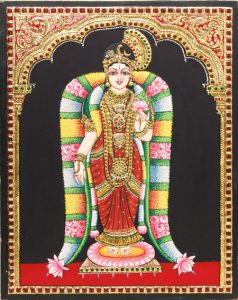
Andal or Kothai Naachiyaar is the only female Alvar among the 12 Alvar saints of South India. The Alvar saints are known for their affiliation to the Srivaishnava tradition of Hinduism.
Andal is credited with the great Tamil works of “Thiruppavai“ and “Nachiar Tirumozhi“, which are still recited by devotees during the winter festival season of Margazhi.
Periazhwar (originally called Vishnuchittar) was an ardent devotee of Perumal and he used to string garland to Perumal every day. He was childless and he prayed to Perumal to save him from the longing.
One day, he found a girl child under a Tulasi plant in a garden inside the temple. The child was goddess Sri Mahalakshmi herself incarnated to test the devotion of Alvars. He and his wife named the child as Kothai, who grew up as a devotee of Kannan, an avatar of Perumal. She is believed to have worn the garland before dedicating it to the presiding deity of the temple. Periazhwar, who later found it, was highly upset and remonstrated her. Sri Vishnudeva appeared in his dream and asked him to dedicate only the garland worn by Andal to him. The girl Kothai was thus named Andal and was referred as சூடிகொடுத்த சுடர்க்கொடி,or Chudikodutha Sudarkodi (lady who wore and gave her garland) to Lord Vishnu. The practice is still followed during modern times when the garland of Andal from Srivilliputhur Andal temple is sent to [Tirumala Venkateswara Temple] on Garudotsavam during the month of Purattaasi (September – October) and [Azhagar Koyil], Madurai during Chitra Pournami festival.
Thiruppavai
A summary: After the sun sets, according to the Vedic scriptures, the period just before the ensuing dawn is called Bramhamuhurtham. It is an auspicious time, for it gives good thoughts and intentions. Practices like meditation and penances done during this hour, give favorable results. According to the Vedic calendar, one Earth-year is equal to one celestial day. So the last six months on the earth (every year) is equal to one celestial night. Hence, the predawn period, the Bramhamuhurtha, for the heavenly beings falls in the month of Dhanurmasam. Andal taught us this Dhanurmasa vratham because she wanted us to spend these auspicious days in contemplation of God. This vratham was performed for Lord Krishna meaning good and happiness.
Nachiar Thirumozhi
Thirumozhi literally means “Sacred Sayings” in a Tamil poetic style and “Nachiar” means goddess. Therefore, the title means “Sacred Sayings of the Goddess.” This poem fully reveals Andal’s intense longing for Vishnu, the divine beloved. Utilizing classical Tamil poetic conventions and interspersing stories from the Vedas and Puranas, Andal creates imagery that is possibly unparalleled in the whole gamut of Indian religious literature.
These 143 pasurams (verses) are organized in 14 segments and each one is called “Tirumozhi”. Each Tirumozhi is named after the first phrase of the first pasuram of that segment. The first Tirumozhi is called
‘tai oru tingalum’ (Tamil : தையொரு திங்கள்) .Similarly all the other Tirumozhis are named after the first phrase of first pasuram. And each Tirumozhi deals with one specific topic.